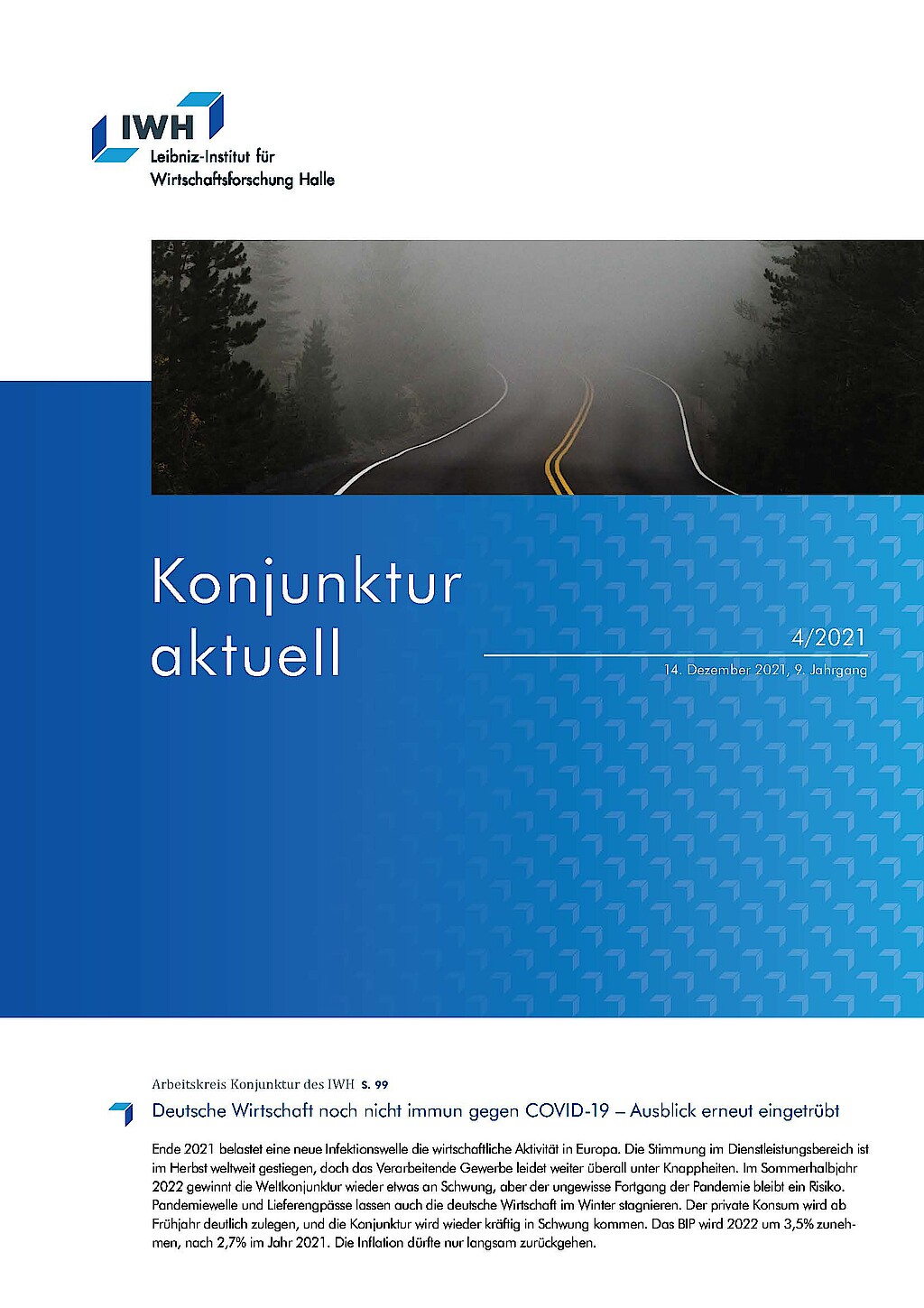Investment, output gap, and public finances in the medium term: Implications of the Second Supplementary Budget 2021
The supplementary budget gives fiscal policy additional leeway for the years in which the debt brake takes effect again. This is because the allocation will be booked as deficit-increasing government expenditure in 2021 when the debt brake is still suspended, but not in later years when the money will actually be spent. In order to estimate the pandemic-related macroeconomic losses to be expected in the medium term, the IWH's current medium-term projection from December 2021 can be compared with the IWH projection from the end of 2019, i. e. before the outbreak of the pandemic. The current projection includes a slightly positive output gap for the years 2023 and 2024, mainly due to catch-up effects in private consumption. However, potential output in the coming years is more than 1.5% below the value projected by the IWH at the end of 2019, mainly due to lower labour supply, partly because of significantly lower immigration. In addition, according to the current projection, fixed capital formation in the coming years is significantly lower than expected in 2019.
The extent to which the supplementary budget might help make up for these shortfalls can be estimated using the IWH's fiscal policy simulation model. According to the simulation, the additional expenditure triggered by the supplementary budget, when its effectiveness is at its peak in 2024, causes overall economic activity to be about 0.5% higher than in the baseline scenario. To roughly the same extent, the additional expenditure leads to an expansion of private investment activity. The expected effects are thus rather small, and the total economic capital stock remains permanently smaller than projected before the pandemic. This has a lasting negative impact on potential output. The impact is, however, much smaller than the negative labour market effects mentioned above.
From a macroeconomic perspective, credit-financed measures to increase public and private investment thus seem justifiable. They could strengthen potential output to some extent, especially since the decarbonisation of the economy is likely to weaken potential output, as it is associated with write-offs of parts of the existing capital stock. It should be taken into account, however, that allocating credit authorisations into a subsidiary budget probably contradicts the intentions of the German debt brake, and its conformity with the constitution is therefore disputed. “Ultimately, policy has to weigh the positive macroeconomic effects of additional investment against the negative effects on the credibility of the debt brake,” says Oliver Holtemöller.
Long version (in German)
Andrej Drygalla, Katja Heinisch, Oliver Holtemöller, Axel Lindner, Götz Zeddies: Investitionen, Auslastungsgrad und Öffentliche Finanzen in der mittleren Frist: Implikationen des Zweiten Nachtragshaushalts 2021, in: IWH, Konjunktur aktuell, Jg. 9 (4), 2021, 141‒148. Halle (Saale) 2021.
Whom to contact
For Researchers

Vice President Department Head
If you have any further questions please contact me.
+49 345 7753-800 Request per E-MailFor Journalists

Internal and External Communications
If you have any further questions please contact me.
+49 345 7753-832 Request per E-MailIWH list of experts
The IWH list of experts provides an overview of IWH research topics and the researchers and scientists in these areas. The relevant experts for the topics listed there can be reached for questions as usual through the IWH Press Office.
Related Publications

Investment, output gap, and public finances in the medium term: Implications of the Second Supplementary Budget 2021
in: Konjunktur aktuell, 4, 2021
Abstract
Die Bundesregierung plant, mit dem Zweiten Nachtragshaushalt 2021 dem Energie- und Klimafonds eine Rücklage in Höhe von 60 Mrd. Euro zuzuführen. Die Mittel sollen in den Folgejahren in Investitionen in den Klimaschutz und die Transformation der Wirtschaft fließen und zugleich gesamtwirtschaftliche Folgekosten der Pandemie verringern. Diese pandemiebedingten Einbußen sind auch in der mittleren Frist erheblich. Zwar dürften Nachholeffekte beim privaten Konsum die im Jahr 2021 noch deutliche Unterauslastung bis zum Jahr 2024 vollständig verschwinden lassen. Jedoch liegt das Produktionspotenzial in den kommenden Jahren mehr als 1,5% unter dem Ende 2019 vom IWH prognostizierten Wert, vor allem wegen eines geringeren Arbeitsangebots, unter anderem aufgrund deutlich niedrigerer Zuwanderung von Arbeitskräften. Die Investitionen sind gemäß aktueller Mittelfristprojektion im Jahr 2024 ebenfalls noch deutlich niedriger. Die Effekte des Nachtragshaushalts auf Investitionstätigkeit und Produktion lassen sich mit Hilfe des finanzpolitischen Simulationsmodells des IWH abschätzen. Die beabsichtigten Mehrausgaben dürften auf dem Höhepunkt ihrer Wirksamkeit im Jahr 2024 die gesamtwirtschaftliche Aktivität um etwa 0,5% steigern. Allerdings werden die zusätzlichen Investitionen die seit Pandemiebeginn ausgebliebene Investitionstätigkeit bei Weitem nicht kompensieren können. Eine Bewertung des Nachtragshaushals hat die positiven gesamtwirtschaftlichen Effekte zusätzlicher Investitionen und die negativen Effekte auf die Glaubwürdigkeit der Schuldenbremse gegeneinander abzuwägen.



